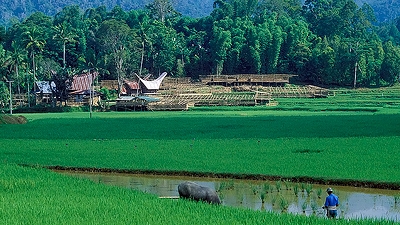By 2050, the Earth will need to feed 9 billion people with the same amount of land and water used today. In practice, this means agricultural production must increase by 70 percent.
The urgency of meeting that challenge is becoming increasingly clear as global food prices remain high and volatile. So is the need for better solutions. Agriculture already accounts for more than two-thirds of the world’s freshwater use, and it is contributing to deforestation. A 70 percent expansion in agriculture production cannot follow the practices of the past and still be sustainable.
The answer lies in pursuing a landscape approach – recognizing that agriculture, water, forests, and food security are all connected.
“You can’t have food security without ecosystem services to sustain agriculture, and you can’t conserve forests and other ecosystems without thinking about how to feed a hungry population, and you can’t grow food without enough water,” says World Bank Agriculture Director Juergen Voegele. “A holistic approach can help us maximize productivity, improve livelihoods, and reduce negative impacts on the environment – all at the same time.”
This holistic approach, incorporating climate-smart agriculture, was embraced by delegates from more than 150 countries during the Global Conference on Agriculture, Food Security, and Climate Change. Their Hanoi Communique encourages developing policies with an integrated approach, putting farmers at the center of innovation, and building partnerships.
Landscape Approach
A landscape approach means managing the land, water, and forest resources necessary to meet an area’s food security needs and promoting inclusive green growth as one system that interacts.
In practice, this might involve restoring degraded parts of the landscape; enhancing productivity on the most fertile land; integrating different production systems such as livestock, crop, and tree production into the same landscape; or watershed management.
In Rwanda, for example, a landscape approach supported by the World Bank and the Global Agriculture and Food Security Program (GAFSP) has included terracing on the steep hillsides, downstream reservoir protection, water harvesting through dams and reservoirs, and hillside irrigation. It works with the water and land as one system and is increasing the yields of smallholder farmers who had been prepared to give up on agriculture altogether. Erosion control means fertilizer and crops are less likely to be washed away.
In Albania, integrating forest, pasture, and agriculture management has shown that with strong involvement of local communities, whole landscapes can recover with dramatic results. Improved forest governance, local management, small-scale investments and managed grazing measures have halted unsustainable land use, thereby reducing carbon emissions and protecting key watersheds. As a result, incomes from forest and agriculture activities have increased by 28 percent in targeted areas.



